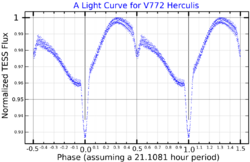Astronomy:HD 165590
Coordinates: ![]() 18h 05m 49.681s, +21° 26′ 45.3894″
18h 05m 49.681s, +21° 26′ 45.3894″
| Observation data Equinox J2000.0]] (ICRS) | |
|---|---|
| Constellation | Hercules |
| Right ascension | 18h 05m 49.682s[2] |
| Declination | +21° 26′ 45.39″[2] |
| Apparent magnitude (V) | 6.94[citation needed] |
| Characteristics | |
| HD 165590A | |
| Evolutionary stage | main sequence |
| Spectral type | G1V+K6V [3] |
| HD 165590B | |
| Evolutionary stage | main sequence |
| Spectral type | G5V[3] |
| Astrometry | |
| ADS 11060AB | |
| Proper motion (μ) | RA: −3.9±0.5[4] mas/yr Dec.: −51.4±0.7[4] mas/yr |
| Parallax (π) | 26.51 ± 1.35[5] mas |
| Distance | 123 ± 6 ly (38 ± 2 pc) |
| ADS 11060C | |
| Proper motion (μ) | RA: −27.515±0.014 mas/yr Dec.: −39.93±0.02 mas/yr |
| Parallax (π) | 24.6940 ± 0.0225[6] mas |
| Distance | 132.1 ± 0.1 ly (40.50 ± 0.04 pc) |
| Details[3] | |
| HD 165590Aa | |
| Mass | 1.09±0.19 M☉ |
| Radius | 0.90 R☉ |
| Surface gravity (log g) | 4.56 cgs |
| Temperature | 5,915 K |
| Metallicity [Fe/H] | −0.13 dex |
| Age | 100 Myr |
| HD 165590Ab | |
| Mass | 0.63±0.15 M☉ |
| Radius | 0.58 R☉ |
| Surface gravity (log g) | 4.71 cgs |
| Temperature | 4,055 K |
| HD 165590B | |
| Radius | 0.91±0.09 R☉ |
| Temperature | 5,590±300 K |
| Age | 100 Myr |
| Other designations | |
ADS 11060, CSI+21 3302 1, GSC 01566-00747, HIP 88637, 2MASS J18054972+2126453, BD+21 3302, SBC9 1024, V772 Her, Gaia DR2 4576326312901654272 | |
| HD 165590A: TYC 1566-747-1, SBC9 1023, CSI+21 3302 6, ADS 11060A | |
| HD 165590B: TYC 1566-747-2, CSI+21 3302 7, ADS 11060B | |
| Database references | |
| SIMBAD | data |
HD 165590 is a quintuple system dominated by the binary Algol variable star known as V772 Herculis. The system lies in the constellation of Hercules about 123 light years from the Sun, and is suspected to be a part of the Pleiades moving group.[5]
System
The primary star is an eclipsing binary ADS 11060A composed of G1 and K6 young main-sequence stars with strong starspot activity.[3] A radio flare from the star V772 Her was detected in 2011.[7] The period of the components of the primary, ADS 11060Aa and ADS 11060Ab, is 0.87950 days.[5]
A main-sequence companion star ADS 11060B of spectral type G5 at a separation of 0.491 arcseconds,[8] is orbiting the primary with a period of 20.08 years.[5]
Also, there is a suspected companion binary star ADS 11060C (Gaia EDR3 4576326312901650560)[6] at a projected separation of 29 arcseconds (1200 AU) from ADS 11060AB. ADS 11060C is composed of K7 and M0 main-sequence stars, orbiting each other with a period of 25.7631 days without eclipses. The binary is a BY Draconis variable[9] with the variable star designation V885 Herculis.
The planetary orbits in the habitable zones in the system ADS 11060AB are unstable due to the gravitational influence of the stellar companions.[10]
References
- ↑ "MAST: Barbara A. Mikulski Archive for Space Telescopes". Space Telescope Science Institute. https://mast.stsci.edu/portal/Mashup/Clients/Mast/Portal.html.
- ↑ 2.0 2.1 Brown, A. G. A. (August 2018). "Gaia Data Release 2: Summary of the contents and survey properties". Astronomy & Astrophysics 616: A1. doi:10.1051/0004-6361/201833051. Bibcode: 2018A&A...616A...1G. Gaia DR2 record for this source at VizieR.
- ↑ 3.0 3.1 3.2 3.3 Reglero, V.; Fernandez-Figuerora, M. J.; Gimenez, A.; De Castro, E.; Fabregat, J.; Cornide, M.; Armentia, J. E. (1991). "The triple system HD 165590 : a spectroscopic and photometric study". Astronomy and Astrophysics Supplement Series 88: 545. Bibcode: 1991A&AS...88..545R.
- ↑ "HD 165590". SIMBAD. Centre de données astronomiques de Strasbourg. http://simbad.u-strasbg.fr/simbad/sim-basic?Ident=HD+165590.
- ↑ 5.0 5.1 5.2 5.3 Zasche, P.; Wolf, M.; Hartkopf, W. I.; Svoboda, P.; Uhlař, R.; Liakos, A.; Gazeas, K. (2009). "A Catalog of Visual Double and Multiple Stars with Eclipsing Components". The Astronomical Journal 138 (2): 664–679. doi:10.1088/0004-6256/138/2/664. Bibcode: 2009AJ....138..664Z.
- ↑ 6.0 6.1 Brown, A. G. A. (2021). "Gaia Early Data Release 3: Summary of the contents and survey properties". Astronomy & Astrophysics 649: A1. doi:10.1051/0004-6361/202039657. Bibcode: 2021A&A...649A...1G. Gaia EDR3 record for this source at VizieR.
- ↑ Bai, J. Y.; Han, J. L.; Gao, X. Y.; Wang, C.; Zhang, L. Y. (2012). "Polarization Observation Experiments for Radio Flares of Stars at 6 cm Band". Acta Astronomica Sinica 53 (4): 291. Bibcode: 2012AcASn..53..291B.
- ↑ Tokovinin, A. A.; Ismailov, R. M. (1988). "Interferometric observations of double stars in 1985 and 1986". Astronomy and Astrophysics Supplement Series 72: 563. Bibcode: 1988A&AS...72..563T.
- ↑ Fekel, Francis C.; Henry, Gregory W.; Hampton, Melissa L.; Fried, Robert; Morton, Mary D. (1994). "Chromospherically Active Stars. XII. ADS 11060 C: A Double Linked K Dwarf Binary in a Quintuple System". The Astronomical Journal 108: 694. doi:10.1086/117106. Bibcode: 1994AJ....108..694F.
- ↑ Benest, D. (2003). "Planetary orbits in the elliptic restricted problem. V.". Astronomy & Astrophysics 400 (3): 1103–1111. doi:10.1051/0004-6361:20030114.
 |


